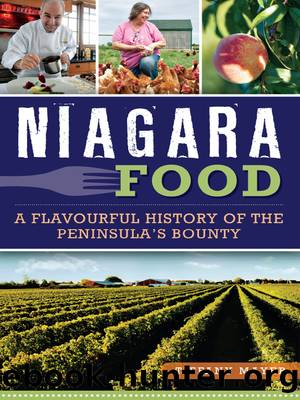Niagara Food by Tiffany Mayer

Author:Tiffany Mayer
Language: eng
Format: epub
Publisher: Arcadia Publishing Inc.
Published: 2014-01-15T00:00:00+00:00
Chef Mark Picone is one of the pioneers of Niagara wine country cuisine and helped make the region a culinary destination. Photo by Nathaniel David Johnson.
Meanwhile, the Prince of Wales Hotel had already been putting its trust in a local chef, Mark Walpole, to make its name synonymous with more than just opulent lodgings. Walpoleâs early days of cookery were in some of those kitchens pushing out those plates of frozen vegetables that made Rinderlin cringe. Walpole, a formally trained chef, was twenty-nine when he was tapped in 1984 to take over the hotelâs kitchen. Owner Henry Wiens told his young culinarian to âdo what you do best within these four walls and donât worry about what the rest are doing,â Walpole remembers. âWe looked inward, not outward, so we were constantly improving.â
Wiens wanted the restaurant to embrace the local wine industry. Walpole did that by hosting wine dinners before they were popular, he says. He had his own gardener to grow herbs and bartered with backyard gardeners for their harvests. Walpole purchased game from Arden Vaughn at Lake Land Meats. His trout came from a fish farm in Fonthill. Word got out among farmers that they should bring their wares to Walpole because he was open to using them in the Prince of Wales kitchen. When he left in 1996, Walpole witnessed a sea change in fine dining in Niagara.
âThere was a difference in the product available. When I started in the business, vegetables were frozen,â he explains. âWhen I worked at the Skylon Tower [in Niagara Falls], we werenât cleaning vegetables. We were thawing broccoli and serving 1,200 people a night.â
He was grateful when Olson, de Luca, Picone and Treadwell arrived to further propel local dining into its own prestigious brand. âIt was nice to be joined. I knew a lot of other chefs in the area, but they were not as forward-thinking,â Walpole says.
Thereâs no denying the effect this quintet of cuisiniers had on Niagara, taking some of the burden off the Falls as the main tourist draw. âWe created a culture here in Niagara that made it a destination people come to for the food,â Picone says. âIt was always a world-class destination, but now that we have people making great wine and great food, it attracted more people.â
Emil Rinderlin was just happy to see kitchens finally eschew tomato juice appetizers and start doing scratch cooking with what has always been here: farm-fresh ingredients. âThey said, âOh, this is regional now,ââ he says with a wry grin about the movement that was afoot at the time. âBut anything that improves the cuisine in a region is good. It was for the betterment of all.â
Download
This site does not store any files on its server. We only index and link to content provided by other sites. Please contact the content providers to delete copyright contents if any and email us, we'll remove relevant links or contents immediately.
| 19th Century | 20th Century |
| Exploration | First Nations |
| Founding | Pre-Confederation |
| Province & Local | War of 1812 |
Cat's cradle by Kurt Vonnegut(14785)
Pimp by Iceberg Slim(13808)
Underground: A Human History of the Worlds Beneath Our Feet by Will Hunt(11848)
4 3 2 1: A Novel by Paul Auster(11821)
The Radium Girls by Kate Moore(11641)
Wiseguy by Nicholas Pileggi(5334)
American History Stories, Volume III (Yesterday's Classics) by Pratt Mara L(5141)
Perfect Rhythm by Jae(5083)
The Fire Next Time by James Baldwin(5033)
Paper Towns by Green John(4812)
Pale Blue Dot by Carl Sagan(4632)
A Higher Loyalty: Truth, Lies, and Leadership by James Comey(4567)
The Mayflower and the Pilgrims' New World by Nathaniel Philbrick(4287)
The Doomsday Machine by Daniel Ellsberg(4253)
Killers of the Flower Moon: The Osage Murders and the Birth of the FBI by David Grann(4197)
Too Much and Not the Mood by Durga Chew-Bose(4105)
The Sympathizer by Viet Thanh Nguyen(4100)
The Borden Murders by Sarah Miller(4032)
Sticky Fingers by Joe Hagan(3916)
